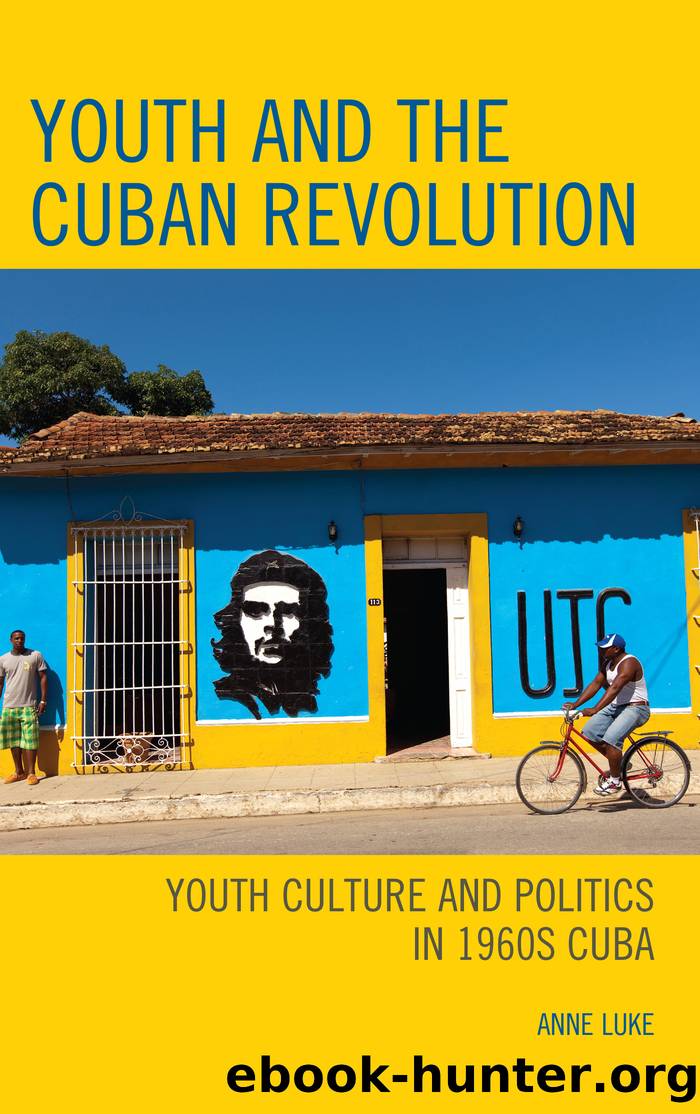Youth and the Cuban Revolution by Luke Anne;

Author:Luke, Anne;
Language: eng
Format: epub
Tags: undefined
Publisher: Lexington Books
Published: 2012-03-15T00:00:00+00:00
Young people would be fed and be provided for by the Revolution in these brigades. Entry thereto did not depend on wealth or education, which certainly would aid recruitment, but there is a further rationale at work here. If indeed the constituency were to comprise those young people who were potentially problematic (in part, as is made clear, by virtue of the lack of opportunities afforded by pre-revolutionary society to those without the financial means to be useful to either themselves or their community), by promising that the Revolution would provide to those young people all they would need to survive, the Revolution was attempting to defuse the so-called problem while relieving families of the burden of supporting a member who was not contributing to the family. The young rebel could be incorporated into the Revolution by his or her activities in the Sierra, while the family could feel a commitment to a Revolution offering its support in a time of need. But of course, a retrospective connection with the rebel struggle of the fifties, and a willingness to be involved in revolutionary initiatives had an appeal well beyond only the underclass, which led to a rapid increase in AJR membership.
One of the key changes to the membership profile of members of the AJR was the incorporation of the militants of the JS into its brigades. In supporting the AJR both in principle and in affiliation, the JS was actually altering the recruitment constituency and profile of the AJR. This was reflected in the expanding role that the AJR came to play. This did not just politicize the AJR; it also militarized the JS. The work of the AJR brigades was essentially military in nature, not least because defense of the country by the people was a core revolutionary goal.
One of the rites of passage of entry to the brigades was that the member should climb the Pico Turquino five times over a three-month period, living the life of the guerrillas. More than 20,000 young Cubans underwent this challenge (Quintela, 1962: 31) and it was seen as a âtest of determination, physical fitness and revolutionary trainingâ (Gómez, n.d. e: 19). Each brigade comprised 100 young men, led by a jefe (Chief) and segundo jefe (Second in Command), who were members of the Ejército Rebelde, and a maestro adoctrinador (Political Commissar). Almost all Political Commissars were members of the JS (Centro de Estudios sobre la Juventud, 1986: 31), which is not surprising because the JS had a long history as a youth organization incorporating political training and so possessed the personnel to fulfil the role of young teachers. For young Cuban women, the Centro Clodomira, a school for underprivileged girls teaching transferable skills, was established (INRA, 1961: 34â41).
From 21st to 24th October 1960 the AJR held its first National Plenary. At this meeting the AJR became independent of the Ejército Rebelde (Centro de Estudios sobre la Juventud, 1986: 63) and became the main youth organization, incorporating all other youth organizations with the exception of the FEU.
Download
This site does not store any files on its server. We only index and link to content provided by other sites. Please contact the content providers to delete copyright contents if any and email us, we'll remove relevant links or contents immediately.
| Antigua | Bahamas |
| Barbados | Cuba |
| Dominica | Dominican Republic |
| Grenada | Haiti |
| Jamaica | Saint Kitts |
| Saint Lucia | Saint Vincent |
| Trinidad and Tobago |
Cat's cradle by Kurt Vonnegut(14760)
Pimp by Iceberg Slim(13780)
Underground: A Human History of the Worlds Beneath Our Feet by Will Hunt(11839)
4 3 2 1: A Novel by Paul Auster(11792)
The Radium Girls by Kate Moore(11621)
Wiseguy by Nicholas Pileggi(5319)
American History Stories, Volume III (Yesterday's Classics) by Pratt Mara L(5136)
Perfect Rhythm by Jae(5072)
The Fire Next Time by James Baldwin(5017)
Paper Towns by Green John(4800)
Pale Blue Dot by Carl Sagan(4619)
A Higher Loyalty: Truth, Lies, and Leadership by James Comey(4552)
The Mayflower and the Pilgrims' New World by Nathaniel Philbrick(4281)
The Doomsday Machine by Daniel Ellsberg(4246)
Killers of the Flower Moon: The Osage Murders and the Birth of the FBI by David Grann(4189)
Too Much and Not the Mood by Durga Chew-Bose(4095)
The Sympathizer by Viet Thanh Nguyen(4095)
The Borden Murders by Sarah Miller(4019)
Sticky Fingers by Joe Hagan(3912)
